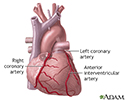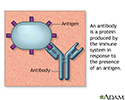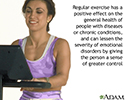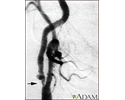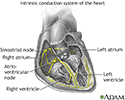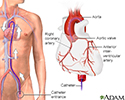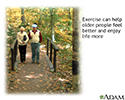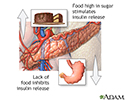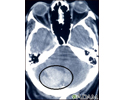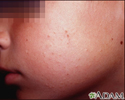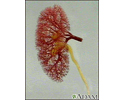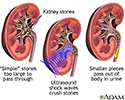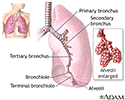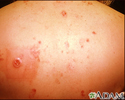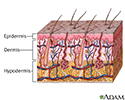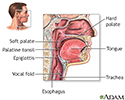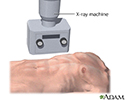Multimedia Gallery
Essential hypertension
Carrying a lot of extra weight around your middle or sprinkling too much salt onto your food at each meal can cause high blood pressure, otherwise known as hypertension. Stress and your genes can also bring your blood pressure up. Sometimes when your blood pressure is high, your doctor might not be able to find any direct cause for it. That's what's called essential hypertension.
When your doctor talks to you about your blood pressure, he's referring to the force of your blood pushing against your artery walls. The top number in your blood pressure is called the systolic blood pressure. That's the pressure in your blood vessels while your heart is pumping. The bottom number is called the diastolic blood pressure and that's the pressure when your heart rests between beats.
You want your blood pressure to stay at 120 over 80 or less. A blood pressure of 140 over 90 or more is considered high. Why is high blood pressure a problem, you ask? Well, you can think of high blood pressure as being like a river that's rushing too hard, eventually it's going to damage its banks. With high blood pressure, the extra force of your blood pushing against your artery walls eventually damages them. It can also damage your heart, your kidneys, and other organs.
So, how do you know if you have high blood pressure?
Often you don't know, because high blood pressure doesn't have symptoms like a fever or cough. Usually there are no symptoms at all, and you won't be able to find out that you have high blood pressure unless you've had it checked, or you've developed complications like heart disease or kidney problems.
You can check your blood pressure yourself with a home monitor, or have it checked at your doctor's office. If it's high, you and your doctor will set a blood pressure goal. You can achieve that goal in different ways, like eating a healthy diet, exercising for at least 30 minutes a day, quitting smoking, eating less than 1,500 milligrams of salt per day, and using programs like meditation and yoga to relieve your stress.
But if these lifestyle changes aren't enough, your health care provider might prescribe one or more medicines to lower your blood pressure.
The reason why doctors are so serious about a patients' blood pressure is that having uncontrolled blood pressure can cause a lot of serious health problems, including heart attack, stroke, kidney disease, and loss of vision. When it comes to your blood pressure, it's best to be proactive. Call your doctor for a check-up if you haven't had one in a while, and get your blood pressure checked. If it's high, follow your doctor's advice for bringing it back into a healthy range.
Essential hypertension
Review Date: 3/6/2025
Reviewed By: Jacob Berman, MD, MPH, Clinical Assistant Professor of Medicine, Division of General Internal Medicine, University of Washington School of Medicine, Seattle, WA. Also reviewed by David C. Dugdale, MD, Medical Director, Brenda Conaway, Editorial Director, and the A.D.A.M. Editorial team.
Animations
- Abdominal aortic aneurysm
- Abdominal pain
- ACL injury
- Acne
- Adolescent depression
- Alcoholic liver disease
- Allergic rhinitis
- Allergies
- Allergy testing
- Allergy to mold - animal da...
- Alzheimer disease
- Alzheimer disease
- Anemia
- Ankle ligament injury
- Ankylosing spondylitis
- Anterior shoulder stretch
- Anti-reflux surgery
- Appendectomy
- Appendicitis
- Arm reach
- Arthritis
- Asperger syndrome
- Asthma
- Atherosclerosis
- Atopic dermatitis
- Atrial fibrillation
- Balloon angioplasty - short...
- Basal cell carcinoma
- Bipolar disorder
- Blood clotting
- Bone fracture repair
- Bronchitis
- Bronchoscopy
- Cardiac catheterization
- Cardiomyopathy
- Carpal tunnel syndrome
- Cataracts
- Cerebral aneurysm
- Chest pain
- Cholesterol and triglycerid...
- Chronic obstructive pulmona...
- Cluster headache
- Colon cancer
- Colorectal polyps
- Common cold
- Concussion
- Concussion
- Coronary artery bypass graf...
- Coronary artery disease
- Crohn disease
- Depression
- Diabetes
- Diabetes - retinal conditions
- Dialysis
- Diarrhea
- Directional coronary athere...
- Electrocardiogram
- Enlarged prostate
- Epilepsy
- Erection problems
- Essential hypertension
- External rotation with band
- Fibromyalgia
- Flu
- Food poisoning
- Foot pain
- Gallstones
- Gastroesophageal reflux disease
- Glaucoma
- Gout
- Hardening of arteries
- HbA1c
- Head injury
- Healthy Guide to Fast Food
- Hearing loss
- Heart attack
- Heart bypass surgery
- Heart failure
- Heartburn
- Heel pain
- Hepatitis A
- Hepatitis B
- Hepatitis C
- Hernia
- Herniated disk
- Herniated nucleus pulposus ...
- Hip joint replacement
- Hodgkin lymphoma
- How do ear tubes come out?
- How to remove a splinter
- How to treat a nosebleed
- How to treat a sunburn
- How to use a peak flow meter
- How to use a pill cutter
- How to use eye drops
- How to use nasal sprays
- Hypertension
- Hypertension - overview
- Hyperthyroidism
- Hypothyroidism
- Insomnia
- Internal rotation with band
- Iron deficiency anemia
- Irritable bowel syndrome
- Isometric
- Kidney stones
- Kidney stones
- Knee joint replacement
- Let's talk about pink eye
- Lung cancer
- Lyme disease
- Melanoma
- Migraine
- Multiple sclerosis
- Nasal congestion
- Neck pain
- Nuclear stress test
- Obstructive sleep apnea
- Osteoarthritis
- Osteoarthritis
- Osteoporosis
- Parkinson disease
- Pendulum exercise
- Peptic ulcer
- Percutaneous transluminal c...
- Pharyngitis
- Plantar fasciitis
- Pneumonia
- Prostate cancer
- Psoriasis
- Retinal detachment
- Rheumatoid arthritis
- Rotator cuff problems
- Sciatica
- Seizures
- Shingles
- Shoulder blade retraction
- Shoulder blade retraction w...
- Shoulder pain
- Sinusitis
- Sleep disorders
- Smoking tips to quit
- Spinal stenosis
- Stent
- Stomach ulcer
- Strep throat
- Stretching back of your shoulder
- Stroke
- Stroke
- Stroke - secondary to cardi...
- Systemic lupus erythematosus
- Tension headache
- The difference between a co...
- Tips on buying cold and flu...
- Tips on removing ear wax
- Tracking your blood pressur...
- Treating eyelid bumps
- Type 1 diabetes
- Type 2 diabetes
- Ulcerative colitis
- Understanding cholesterol r...
- Up the back stretch
- Urinary incontinence
- Urinary tract infection - adults
- Vacation health care
- Varicose veins
- Venous insufficiency
- Wall push-up
- Wall stretch
- Warts
- What are hives?
- What causes wheezing?
- What in the world is a neti pot?
- What is tennis elbow?
- What makes your heart beat?
- What to do when something g...
Illustrations
- 15/15 rule
- Abdominal organs
- Abdominal quadrants
- Abdominal ultrasound
- ACL degrees
- ACL injury
- Acne - close-up of cysts on...
- Acne - close-up of pustular...
- Acne - cystic on the back
- Acne - cystic on the chest
- Acne - cystic on the face
- Acne - vulgaris on the back
- Acne on the back
- Acrodermatitis
- Acute MI
- Adult facial acne
- Aerobic exercise
- Aged hair follicle
- Aged male reproductive system
- Aging changes in nails
- AIDS
- Alcohol and diet
- Alcohol use disorder
- Alcoholism
- Alopecia areata with pustules
- Alopecia totalis - back vie...
- Alopecia totalis - front vi...
- Alopecia, under treatment
- Alpha-glucosidase inhibitors
- Alzheimer disease
- Anal sphincter anatomy
- Anatomical landmarks adult ...
- Angina
- Ankle sprain
- Ankle sprain swelling
- Anterior cruciate ligament ...
- Anterior heart arteries
- Antibodies
- Aortic aneurysm
- Aortic stenosis
- Appendicitis
- Arterial plaque build-up
- Arterial tear in internal c...
- Artery cut section
- Asymptomatic HIV infection
- Atherosclerosis
- Atherosclerosis of internal...
- Atherosclerosis of the extr...
- Athlete's foot - tinea pedis
- Atopic dermatitis
- Atopy on the ankles
- Atrioventricular block - EC...
- Baker cyst
- Balance receptors
- Barium enema
- Basal cell cancer
- Basal Cell Carcinoma - close-up
- Basal cell carcinoma - close-up
- Basal Cell Carcinoma - face
- Basal cell carcinoma - nose
- Basal cell nevus syndrome -...
- Basal cell nevus syndrome -...
- Basal cell nevus syndrome -...
- Battle's sign - behind the ear
- Benefit of regular exercise
- Benign juvenile melanoma
- Bicycle helmet - proper usage
- Biguanides
- Bipolar disorder
- Blackheads (comedones)
- Blackheads (comedones) close-up
- Bladder biopsy
- Bladder catheterization - male
- Blood in semen
- Blood pressure
- Blood pressure check
- Blood test
- Blood test
- Bone graft harvest
- Bowen's disease on the hand
- BPH
- Bradycardia
- Brain
- Brain wave monitor
- Brainstem function
- Brittle nails
- Bronchial cancer - CT scan
- Burns
- Bursa of the elbow
- Bursa of the knee
- Bursitis of the shoulder
- Calcium benefit
- Calcium source
- Calculating body frame size
- Calories and fat per serving
- Canker sore (aphthous ulcer)
- Cardiac arteriogram
- Cardiac catheterization
- Cardiac catheterization
- Carotid duplex
- Carotid stenosis - X-ray of...
- Carotid stenosis - X-ray of...
- Carpal tunnel surgical procedure
- Carpal tunnel syndrome
- Cauda equina
- Cellulitis
- Cellulitis on the arm
- Central nervous system
- Central nervous system and ...
- Cerebellum - function
- Cerebral aneurysm
- Cervical spondylosis
- Chafing of the skin
- Changes in face with age
- Chapped hands
- Chapped lips
- Cheilitis - actinic
- Chest stretch
- Cholecystitis - cholangiogram
- Cholecystitis, CT scan
- Cholecystolithiasis
- Cholesterol
- Cholesterol producers
- Circle of Willis
- Circulation of blood throug...
- Circulatory system
- Colon culture
- Colonoscopy
- Colonoscopy
- Complex carbohydrates
- Compression fracture
- Compression of the median nerve
- Concussion
- Conduction system of the heart
- Coronary angiography
- Coronary artery blockage
- Coronary artery disease
- Coronary artery disease
- Coronary artery spasm
- Coronary artery stent
- Crab lice
- Crab louse, female
- CSF test for syphilis
- CT scan
- Cystoscopy
- DASH diet
- Deep anterior muscles
- Deep veins
- Deep veins
- Deep venous thrombosis - il...
- Depression among the elderly
- Depression and heart disease
- Depression and insomnia
- Depression and men
- Dermatitis - atopic in an infant
- Dermatitis - atopic on a yo...
- Dermatitis - atopic on the arms
- Dermatitis - atopic on the legs
- Dermatitis - seborrheic on ...
- Dermatitis seborrheic - close-up
- Developmental process of at...
- Diabetes and exercise
- Diabetic blood circulation ...
- Diabetic emergency supplies
- Diabetic retinopathy
- Diet and disease prevention
- Different types of weight gain
- Digestive system
- Dislocation of the hip
- Doppler ultrasonography of ...
- Drug induced hypertension
- Ear anatomy
- Early treatment of injury
- ECG
- Eczema, atopic - close-up
- Effects of age on blood pressure
- Elbow - side view
- Electrocardiogram (ECG)
- Emphysema
- Endarterectomy
- Endocrine glands
- Enlarged view of atherosclerosis
- Erection self-test
- Erythema annulare centrifug...
- Erythema multiforme on the leg
- Erythema multiforme, circul...
- Erythema multiforme, target...
- Erythema toxicum on the foot
- Exercise - a powerful tool
- Exercise 30 minutes a day
- Exercise and age
- Exercise and heart rate
- Exercise can lower blood pr...
- Exercise with friends
- External fixation device
- Fast food
- Fatty liver - CT scan
- Fears and phobias
- Femoral hernia
- Fish in diet
- Folliculitis - decalvans on...
- Food and insulin release
- Foot swelling
- Foreskin
- Forms of depression
- Fracture types (1)
- Fracture types (2)
- Fracture, forearm - x-ray
- Fractures across a growth plate
- Fruits and vegetables
- Fungus
- Gallbladder
- Generalized anxiety disorder
- Glucose in blood
- Glucose test
- Groin stretch
- Hair follicle
- Hair follicle anatomy
- Hair follicle of young person
- Hair follicle sebaceous gland
- Half and half nails
- Hamstring stretch
- Head injury
- Head louse and pubic louse
- Head trauma
- Headache
- Healthy diet
- Healthy diet
- Heart - front view
- Heart - section through the...
- Heart attack symptoms
- Heart beat
- Heart chambers
- Heart valves
- Heart valves - anterior view
- Heart valves - superior view
- Herniated disk repair
- Herniated lumbar disk
- Herniated nucleus pulposus
- Herpes simplex - close-up
- Herpes zoster (shingles) di...
- Herpetic whitlow on the thumb
- Hiatal hernia - x-ray
- High blood pressure tests
- Hip stretch
- Histoplasmosis, disseminate...
- HIV
- Holter heart monitor
- Hunger center in brain
- Hydrocele
- Hyperlinearity in atopic de...
- Hyperlinearity in atopic de...
- Hypertension
- Immune system structures
- Impingement syndrome
- Indications of head injury
- Infant skull fracture
- Inflamed Achilles tendon
- Inflamed shoulder tendons
- Inflatable artificial sphincter
- Ingrown toenail
- Inguinal hernia
- Insulin production and diabetes
- Insulin pump
- Insulin pump
- Internal fixation devices
- Intestinal gas
- Intracerebellar hemorrhage ...
- Intravenous pyelogram
- Intravenous pyelogram (IVP)
- Irregular sleep
- Islets of Langerhans
- Isometric exercise
- Janeway lesion on the finger
- Kaposi sarcoma - close-up
- Kaposi sarcoma - lesion on ...
- Kaposi sarcoma - perianal
- Kaposi sarcoma on the back
- Kaposi's sarcoma on the thigh
- Keratoacanthoma
- Keratoacanthoma
- Keratosis pilaris - close-up
- Keratosis pilaris on the cheek
- Kidney - blood and urine flow
- Kidney anatomy
- Kidney function
- Kidneys
- Knee arthroscopy
- Knee joint replacement pros...
- Knee pain
- Koilonychia
- Kyphosis
- Large intestine (colon)
- Lateral collateral ligament
- Lateral collateral ligament...
- Lateral collateral ligament pain
- Late-stage syphilis
- Left atrial myxoma
- Left cerebral hemisphere - ...
- Leg pain (Osgood-Schlatter)
- Leg skeletal anatomy
- Lentigo - solar on the back
- Lentigo - solar with erythe...
- Lichen simplex chronicus on...
- Lifestyle changes
- Lipocytes (fat cells)
- Lithotripsy procedure
- Liver anatomy
- Liver cirrhosis - CT scan
- Liver with disproportional ...
- Lobes of the brain
- Low blood sugar symptoms
- Lower digestive anatomy
- Lower leg edema
- Lower leg muscles
- Lower leg muscles
- Lumbar vertebrae
- Lung mass, right lung - CT scan
- Lung mass, right upper lobe...
- Lung nodule, right lower lu...
- Lung with squamous cell can...
- Lungs
- Lymphatic system
- Male pattern baldness
- Male reproductive anatomy
- Male reproductive anatomy
- Male reproductive system
- Male urinary tract
- Malignant melanoma
- Mandibular fracture
- Medial collateral ligament
- Medial collateral ligament ...
- Medial collateral ligament pain
- Melanoma
- Melanoma - neck
- Melanoma of the liver - MRI scan
- Meniscal tears
- Mitral stenosis
- Mitral valve prolapse
- Molluscum contagiosum on th...
- Molluscum on the chest
- Monitoring blood pressure
- MRI scans
- MUGA test
- Multiple basal cell cancer ...
- Muscle cells vs. fat cells
- Muscle pain
- Muscle strain
- Muscular atrophy
- Mycobacterium marinum infec...
- Nail infection - candidal
- Nasal fracture
- Neck pulse
- Nephrolithiasis
- Normal anatomy of the heart
- Normal foot x-ray
- Normal heart anatomy (cut s...
- Normal heart rhythm
- Normal knee anatomy
- Normal lung anatomy
- Normal uterine anatomy (cut...
- Obesity and health
- Obsessive-compulsive disorder
- Omega-3 fatty acids
- Onycholysis
- Oral anatomy
- Osteoarthritis
- Osteoarthritis
- Osteogenic sarcoma - x-ray
- Osteoporosis
- Pacemaker
- Pancreas
- Parathyroidectomy
- Patellar dislocation
- Pathway of sperm
- Pelvic laparoscopy
- Penis - with and without fo...
- Physical activity - prevent...
- Phytochemicals
- Plantar wart
- Plaque buildup in arteries
- Poison ivy on the knee
- Poison ivy on the leg
- Poison oak rash on the arm
- Post myocardial infarction ...
- Posterior cruciate ligament...
- Posterior heart arteries
- Post-traumatic stress disorder
- Prevention of heart disease
- Primary HIV infection
- Primary syphilis
- Progressive build-up of pla...
- Prostate cancer
- Prostate cancer
- Prostate gland
- Proteins
- PSA blood test
- Psoriasis - guttate on the ...
- Psoriasis - guttate on the cheek
- Psoriasis on the knuckles
- Pubic louse-male
- Pulmonary nodule, solitary ...
- Quitting smoking
- Radial head injury
- Radial pulse
- Rectal biopsy
- Rectal cancer - x-ray
- Respiratory cilia
- Retrocalcaneal bursitis
- Rheumatoid arthritis
- Rheumatoid arthritis
- Rheumatoid arthritis
- Rheumatoid arthritis
- Right atrial myxoma
- Right cerebral hemisphere -...
- Ringworm, tinea capitis - c...
- Roseola
- Rotator cuff muscles
- Saturated fats
- Schizoaffective disorder
- Schizophrenia
- Sciatic nerve
- Sciatic nerve damage
- Scoliosis
- Scrotal mass
- Secondhand smoke and lung cancer
- Selenium - antioxidant
- Shin splints
- Shingles
- Shoulder arthroscopy
- Shoulder joint
- Shoulder joint inflammation
- Sigmoid colon cancer - x-ray
- Simple carbohydrates
- Skeletal spine
- Skeleton
- Skin
- Skin cancer - close-up of l...
- Skin cancer - close-up of l...
- Skin cancer - malignant melanoma
- Skin cancer - melanoma supe...
- Skin cancer - raised multi-...
- Skin cancer - squamous cell...
- Skin cancer, basal cell car...
- Skin cancer, basal cell car...
- Skin cancer, basal cell car...
- Skin cancer, basal cell car...
- Skin cancer, close-up of le...
- Skin cancer, melanoma - fla...
- Skin cancer, melanoma - rai...
- Skin cancer, melanoma on th...
- Skin cancer, squamous cell ...
- Skin layers
- Skull fracture
- Skull fracture
- Skull of an adult
- Sleep patterns in the young...
- Smoking hazards
- Sodium content
- Sperm
- Spermatocele
- Spinal anatomy
- Spinal cord injury
- Spinal stenosis
- Spinal stenosis
- Spine supporting structures
- Spleen and liver metastases...
- Sprained ankle
- Squamous cell cancer
- Squamous cell carcinoma - i...
- St. John's Wort
- Stable angina
- Stages of cancer
- Starchy foods
- STDs and ecological niches
- Stress incontinence
- Stress incontinence
- Stroke
- Structure of the colon
- Subungual wart
- Sulfonylureas drug
- Sun protection
- Sunburn
- Surface anatomy - normal palm
- Surface anatomy - normal wrist
- Swollen lymph nodes in the groin
- Synovial fluid
- Syphilis - secondary on the...
- Systemic lupus erythematosu...
- Taking your carotid pulse
- Tendinitis
- Tendon vs. ligament
- Tendonitis
- Tendons and muscles
- Testicular anatomy
- Testicular biopsy
- Testicular ultrasound
- The large intestine
- The structure of a joint
- Thiazolidinediones
- Thigh stretch
- Throat anatomy
- Thrombus
- Thyroid cancer - CT scan
- Tobacco and cancer
- Tobacco and chemicals
- Tobacco and vascular disease
- Tobacco health risks
- Torn lateral collateral ligament
- Torn medial collateral ligament
- Trans fatty acids
- Transient Ischemic attack (TIA)
- Treatment for leg strain
- Triceps stretch
- Trichotillomania - top of t...
- Tuberculosis in the lung
- Type I diabetes
- Untreated hypertension
- Uric acid crystals
- Varicocele
- Varicose veins
- Venous blood clot
- Ventricular tachycardia
- Vertebra, cervical (neck)
- Vertebra, lumbar (low back)
- Vertebra, thoracic (mid back)
- Vertebral column
- Vertigo
- Visual acuity test
- Visual field test
- Vitamin B12 benefits
- Vitamin B12 source
- Vitamin B6 benefit
- Vitamin B6 source
- Vitamin C benefit
- Vitamin C deficit
- Vitamin C source
- Vitamin D benefit
- Vitamin D deficit
- Vitamin D source
- Vitamin E benefit
- Vitamin E source
- Wart
- Wart (close-up)
- Wart (verruca) with a cutan...
- Warts - flat on the cheek a...
- Warts, multiple - on hands
- Weight loss
- White nail syndrome
- Wrist anatomy
- Wrist splint
- X-ray
- X-ray
- Yellow nail syndrome
- Yellow nails
- Young male reproductive system
- Yo-yo dieting
Presentations
- Ankle sprain - Series
- Anterior cruciate ligament ...
- Appendectomy - series
- Arterial bypass leg - series
- Bone fracture repair - series
- Carotid artery surgery - series
- Carpal tunnel repair - series
- Circumcision - series
- Colon cancer - series
- Colostomy - series
- Coronary artery balloon ang...
- Diaphragmatic hernia repair...
- Facelift - series
- Gallbladder removal - Series
- Heart bypass surgery - series
- Heart transplant - series
- Heart valve surgery - series
- Hemorrhoid surgery - series
- Hiatal hernia repair - series
- Inflatable artificial sphin...
- Inguinal hernia repair - series
- Kidney removal (nephrectomy...
- Knee arthroscopy - series
- Knee joint replacement - series
- Laparoscopic surgery - series
- Large bowel resection - series
- Lumbar spinal surgery - series
- Microdiskectomy - series
- Monitoring blood glucose - ...
- Parathyroidectomy - series
- Prostatectomy - Series
- Rotator cuff repair - series
- Shoulder separation - series
- Small bowel resection - series
- Spinal fusion - series
- Spinal surgery - cervical -...
- Stroke - series
- Testicular torsion repair -...
- Thyroidectomy - series
- Transurethral resection of ...
- Two person roll - series
- Umbilical hernia repair - ...
- Venous thrombosis - series

 Bookmark
Bookmark




















































































































































































































